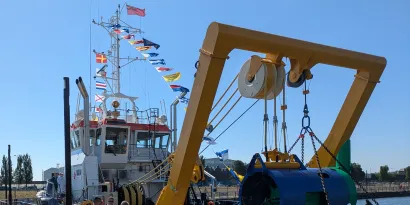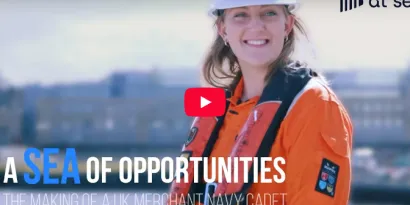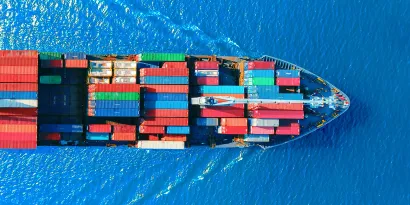Every year, on 25 June, we celebrate the Day of the Seafarer.
There are an estimated 1.64 million seafarers across the globe serving on internationally trading merchant ships, 21,970 of which are UK seafarers.
Without their skills and dedication, we would lack so many of the basic necessities society depends upon, as up to 90% of the world’s food, fuel, raw materials, and manufacturer goods are transported by sea.
On this day, the International Maritime Organisation (IMO) invites governments, shipping companies, organisations, and all those in associated industries to come together on this day and recognise the vital contribution seafarers make to global trade and the economy – often, at great personal cost to their own lives and their families. Battling through long voyages, extended periods away from loved ones, rough weather, dangerous piracy zones, health hazards and other difficult issues to ensure goods get where they need to go.
The theme for 2022 is “Your voyage, then and now, share your journey”, focusing on seafarer journeys, what it includes, and how it has developed over time. The IMO is inviting seafarers to post two photos, one of their first ever journey and another of their most recent voyage, highlighting what has changed over the years – be it technology, sustainability, their skill set, or more.
Reflecting on the journey of his maritime career, which began as a cadet with a coastal shipping company in the 90’s, Ian Blair, Deputy Director of UK Maritime Services at the Maritime and Coastguard Agency, shares the changes he’s seen during his transition from ship to shore.
“When I completed my cadetship and became a third officer I went from sailing between ports in the UK and Europe to suddenly travelling the world. For a young man who hadn’t really been outside of Europe, boarding a flight for Korea was pretty exciting.
“Life back then was different. It cost £5 per minute to phone home from the ship, and there were bars where socialising was actively encouraged. I was fortunate throughout my seagoing career to have sailed with really good people, but life at sea can be difficult and quite isolating. I made the decision to step ashore when my second son was born, watching the sadness in my families’ eyes when I left to join the ship became more difficult.
“Now I can do my bit to make sure that those who choose to work at sea now are provided with a safe environment in which to do that. When I reflect on how safety and wellbeing of seafarers has changed over the course of my career, it’s pretty drastically. International Safety Management and the Maritime Labour Convention have both made a positive impact and wellbeing is moving further and further up the safety agendas.”
The Maritime and Coastguard Agency is proud to have played a part in helping to improve the wellbeing and safety of seafarers. As part of Day of the Seafarer, we’re sharing a snippet of our journey and some of the changes implemented.
Some of the changes we've implemented:
- Collaborated with the Maritime Charities Group (MCG) on a standard for mental health training – Due to a growing mental health crisis among seafarers and concern about the generic content offered in training courses, the MCA took part in a working group, which included the MNTB, trade unions, maritime charities, and academics, to help create a standard for mental health training courses. Written by experts from the maritime and education sectors, the guide contains best practice advice for designing mental health and wellbeing awareness courses for seafarers.
- Produced Wellbeing at Sea guides – The two guides, one for organisations and one for seafarers, are designed to help with the challenges of being at sea for a long time and were created in consultation with unions, ship owners, and maritime charities. Written by health experts, the guides contain pragmatic advice to help with issues such as loneliness, isolation, fatigue, and the personal struggles of being separated from loved ones for extended periods.
- Worked with the Merchant Navy Training Board (MNTB) to introduce a mental health component to Personal Safety & Social Responsibilities (PSSR) training.
- Relaunched the MCA’s Human Element Advisory Group (HEAG) – HEAG is an industry-wide working group established to undertake and collaborate on projects based on the priorities established by Human Element Strategy Group (HESG). priority for the next meeting is just culture in the maritime industry.
- Participated in the first global conference on seafarer mental health – Alongside others from the ImarEST Mental Health Special Interest Group (SIG), the MCA participated in the first conference with Hazel Lewis, the MCA’s Seafarer Safety and Human Element Policy Manager
- Produced the MCA’s Safety Culture Strategy – Which incorporated ideas from discussions at HEAG meetings.
- Published a maritime version of the Safety Climate Tool – The MCA collaborated with the Health and Safety Executive (HSE) to build on the success of the Safety Climate Tool and make it more applicable for the maritime sector, which has unique health and safety requirements. The tool is designed to help companies measure and continually improve safety culture onboard, with the hope that it would help reduce incidents. The collaboration formed part of the UK Flag’s commitment to continually drive improved safety awareness.
Further seafarer wellbeing elements coming soon
- The Maritime and Coastguard Agency, with the Department for Transport, have worked with Ipsos Mori on research into seafarer suicide. The results of the research are due to be published shortly.
- We have helped to develop a Wellbeing at sea tool, trials of which are just finishing. The tool is due to be launched in July.
We say thank you to seafarers across the globe for all have done and continue to do for us.
Join the conversation on social media and share your experiences of seafaring, using the hashtag #SeafarerJourney
-
Share


